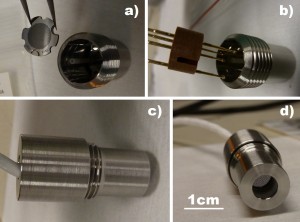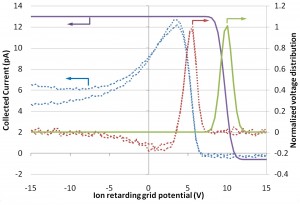Batch-micromachined RPAs for Plasma and Ion Measurements
- Category: MEMS & BioMEMS
- Tags: Akintunde Akinwande, Eric Heubel, Luis Velásquez-García
Retarding potential analyzers (RPAs) were first developed in the 1960’s. RPAs find widespread application including characterization of near-spacecraft environments and assessment of the propulsion efficiency of plasma-based space thrusters. In this project we are exploring the multiplexing and scaling-down limits of RPAs using micro and nanotechnology. Miniaturized RPAs will weigh visibly less, which will reduce the cost of a nanosatellite-based mission. Also, miniaturized RPAs will provide better diagnostics of spacecraft plasma plumes as smaller projected area will be less disruptive to plasma under observation. In addition, batch-fabricated miniaturized RPAs can be used as part of a spacecraft “sensorial skin” that provides detailed local information of the plasma surrounding the spacecraft, particularly during re-entry, when monitoring exterior conditions is essential to ensuring safety during the mission.
An improvement of our work from the state-of-the-art RPAs is the introduction of enforced aperture alignment. When the apertures of each successive grid are aligned, the optical transparency of the sensor increases, which should result in improved signal strength. We recently developed a first-generation prototype of a hybrid microRPA (Figure 1). The hybrid microRPA has micromachined electrodes and a stainless steel housing. Internal dynamics of this type of energy analyzer, however, are more complex than simple transmission or reflection of the various ion species [1] [2] . This fact is made evident by the experimental characterization of the microRPA using a commercial thermionic ion source for mass spectrometry. Figure 2 shows that the measured data reveal a peak in the energy distribution function around 5.4 V of retarding potential when the ionization region is at 10 V. Therefore, the observed ion energy distribution (dotted) deviates from the expected (continuous line) by approximately 4.6 V, a shift that is constant for a wide range of ionization region potentials. We speculate that changes in the internal dynamics due to enforced aperture alignment, sources of error in the applied voltages due to the materials selected, or a combination thereof are cause for this anomaly. Exploration of these potential sources of error continues, as well as the manufacturing of a fully batch-microfabricated RPA sensor with housing based on 3D HV packaging technology [3] [4] .
- Figure 1: Assembly of a hybrid RPA. a) Micromachined grids are placed in a stainless steel housing, alumina spacers and guiderails enforce alignment and separation distance. b) Contact is made to each tungsten-coated electrode through gold pogo pins. c) and d) Completed assembly.
- Figure 2: Experimental RPA data. Ions generated with a thermionic source at -50 eV energy and 0.2 mA emission current are accelerated through 10 V of potential. The figure shows the measured (dotted) and expected (continuous line) data.
- C. K. Chao and S.-Y. Su, “Charged particle motion inside the retarding potential analyzer,” Physics of Plasmas, vol. 7, no. 1, pp. 101-107, Jan. 2000. [↩]
- C. L. Enloe and J. R. Shell, 2nd, “Optimizing the energy resolution of planar retarding potential analyzers,” Review of Scientic Instruments, vol. 63, no. 2, pp. 1788-1791, Feb. 1992. [↩]
- L. F. Velásquez-García, A. I. Akinwande, and M. Martínez-Sánchez, “Precision hand assembly of MEMS subsystems using DRIE-patterned deflection spring structures: An example of an out-of-plane substrate assembly,” Journal of Microelectromechanical Systems, vol. 16, no. 3, pp. 598–612, 2007. [↩]
- B. Gassend, L. F. Velásquez-García, and A. I. Akinwande, “Precision in-plane hand assembly of bulk-microfabricated components for high-voltage MEMS arrays applications,” Journal of Microelectromechanical Systems, vol. 18, no. 2, pp. 332-346, Apr. 2009. [↩]

